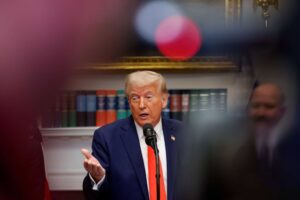The US economy shrank in the first quarter of 2025, marking its first contraction since early 2022, as a surge in imports ahead of President Trump’s sweeping new tariffs dragged down output, official figures show.
Gross domestic product (GDP) fell by 0.3% on an annualised basis between January and March, according to the US Bureau of Economic Analysis (BEA), ending a period of strong post-pandemic growth. The figure was worse than the 0.2% drop expected by analysts and a sharp reversal from 2.4% growth in the previous quarter.
The contraction was largely caused by a 41.3% spike in imports, as businesses rushed to stockpile foreign goods before tariffs took full effect. Since imports subtract from GDP, this surge had a negative impact on the growth figures. America’s goods trade deficit also hit a record high in March.
Wall Street reacted sharply to the news, with early losses across major indices. However, markets stabilised by close: the Dow Jones rose 0.4%, the S&P 500 edged up 0.2%, and the Nasdaq recovered from a steep drop to end just 0.1% lower.
Economists believe the downturn may be temporary. Paul Ashworth of Capital Economics noted that the import surge is already reversing, which “should boost second-quarter GDP.” ING’s James Knightley said businesses were “desperately trying to bring in as many goods as possible ahead of tariffs.”
The downturn coincides with the rollout of Trump’s “liberation day” tariff plan, announced on April 2. The plan imposes a blanket 10% tariff on all imports, a 145% charge on Chinese goods, and additional sector-specific levies. Trump later delayed implementation of most tariffs by 90 days, but core charges remain in place.
Despite the contraction, Trump blamed his predecessor in a Truth Social post:
“This is Biden’s Stock Market, not Trump’s. Tariffs have NOTHING TO DO WITH IT. Our Country will boom… BE PATIENT!!!”
Adding to economic headwinds was a drop in government spending, tied in part to a sharp reduction in public sector staff overseen by Elon Musk, head of the Department of Government Efficiency (Doge).
Major investment banks including Goldman Sachs, JP Morgan, and Morgan Stanley have since downgraded their US growth forecasts. JP Morgan now sees a 60% chance of recession in the coming months.
Inflation also showed signs of re-accelerating. The core personal consumption expenditures (PCE) index, the Federal Reserve’s preferred inflation gauge, rose to 3.5%, up from 2.6% and higher than expected.
Meanwhile, the eurozone economy delivered a rare bright spot, growing by 0.4% in Q1, double the previous quarter’s pace. Germany and France narrowly avoided recession, buoyed by interest rate cuts by the ECB and a new €500 billion investment plan announced by Germany’s incoming chancellor Friedrich Merz.
However, analysts warned that Trump’s tariffs — which currently subject the EU to a 10% blanket rate and could rise to 20% — may weigh on future European growth. Christophe Boucher of ABN Amro called the latest eurozone GDP data “a good surprise,” but cautioned it “does not take into account the ‘liberation day’ shock.”
As global markets adjust to Trump’s protectionist policies, economists are watching closely for signs of deeper disruption — and whether the US contraction marks a blip or the beginning of a broader slowdown.
Read more:
US economy shrinks for first time since 2022 as Trump tariffs rattle markets
